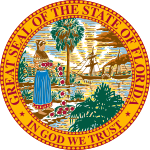| |||||||||||||||||||||||||||||||||
| |||||||||||||||||||||||||||||||||
 County Results
| |||||||||||||||||||||||||||||||||
| |||||||||||||||||||||||||||||||||
| Elections in Florida |
|---|
 |
|
|
The 1908 United States presidential election in Florida was held on November 3, 1908 as part of the 1908 United States presidential election. Voters chose five representatives, or electors to the Electoral College, who voted for President and Vice-President. With the disenfranchisement of African-Americans by a poll tax in 1889,[1] Florida become a one-party Democratic state, which it was to remain until the 1950s, apart from the anti-Catholic vote against Al Smith in 1928. Unlike southern states extending into the Appalachian Mountains or Ozarks, or Texas with its German settlements in the Edwards Plateau, Florida completely lacked upland or German refugee whites opposed to secession. Thus Florida's Republican Party between 1872 and 1888 was entirely dependent upon black votes, a fact is graphically seen when one considers that – although very few blacks in Florida had ever voted within the previous fifty-five years – at the time of the landmark court case of Smith v. Allwright, half of Florida's registered Republicans were still black.[2] Thus disfranchisement of blacks and poor whites left Florida as devoid of Republican adherents as Louisiana, Mississippi, or South Carolina.[3]
Florida was won by the Democratic nominees, former Representative William Jennings Bryan of Nebraska and his running mate John W. Kern of Indiana. They defeated the Republican Party nominees, former Secretary of War William Howard Taft of Ohio and his running mate James S. Sherman of New York. Bryan won the state by a margin of 41.43%.
Nevertheless, Florida's one-party Democratic rule was to be marginally interrupted in the 1900s by considerable Socialist and Populist growth, centered in Tampa and Jacksonville, and southern Lee County with its "Koreshan Unity" sect[4] Immigrants and farmers fearing loss of tenure were able to give Eugene V. Debs, in the second of his five Presidential runs, over ten percent of the vote in several counties of South Florida, and Populist Thomas E. Watson substantial votes in many pineywoods counties.
1908 saw several major strikes in the state, notably of railcars in Pensacola,[4] and Debs was able to improve upon his 1904 vote to the extent of running second in five counties. However, Bryan still carried the state by a three-to-one margin over his nearest rival.
Bryan had previously won Florida twice against William McKinley in both 1896 and 1900.
- ^ Silbey, Joel H. and Bogue, Allan G.; The History of American Electoral Behavior, p. 210 ISBN 140087114X
- ^ See Price, Hugh Douglas; 'The Negro and Florida Politics, 1944-1954'; The Journal of Politics, Vol. 17, No. 2 (May, 1955), pp. 198-220
- ^ Phillips, Kevin P.; The Emerging Republican Majority, pp. 208, 210 ISBN 9780691163246
- ^ a b Griffin, R. Steven; ‘Workers of the Sunshine State, Unite! The Florida Socialist Party during the Progressive Era, 1900-1920’ (thesis)
© MMXXIII Rich X Search. We shall prevail. All rights reserved. Rich X Search



